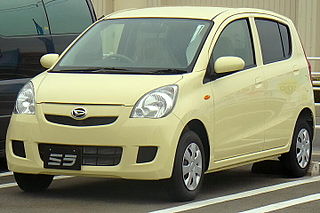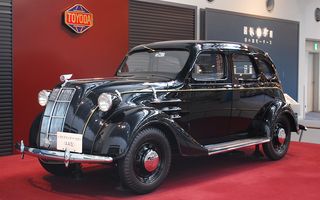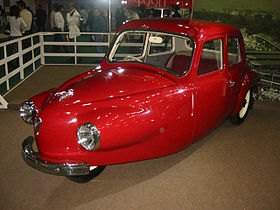
Daihatsu Motor Co., Ltd., commonly known as Daihatsu, is a Japanese automobile manufacturer and one of the oldest surviving Japanese internal combustion engine manufacturers. The company's headquarters are located in Ikeda, Osaka Prefecture.

The Arnold was one of the first motor cars manufactured in the United Kingdom. It was produced in East Peckham, Kent between 1896 and 1898.

L'Aster, Aster, Ateliers de Construction Mecanique l'Aster, was a French manufacturer of automobiles and the leading supplier of engines to other manufacturers from the late 1890s until circa 1910/12. Although primarily known as an engine mass manufacturer the company also produced chassis for coach-works and a complete range of components.

The Daihatsu Midget is a single-seater mini-truck, later a microvan/kei truck made by Japanese automaker Daihatsu. Several distinct vehicles have borne the Midget name over the years, but all have had in common a single or two-seat utilitarian design, with an enclosed or semi-enclosed cab. Its appearance is very similar to the Cushman Truckster introduced in 1952.

De Dion-Bouton was a French automobile manufacturer and railcar manufacturer operating from 1883 to 1953. The company was founded by the Marquis Jules-Albert de Dion, Georges Bouton, and Bouton's brother-in-law Charles Trépardoux.

The Daihatsu Mira is a kei car and city car built by Japanese car maker Daihatsu. It has a variety of options and chassis variations, with the latest variant having four models: Mira, Mira AVY, Mira Gino, and Mira VAN. The Mira is the latest successor to the line of cars begun with the Daihatsu Fellow of 1966, and was originally introduced as the commercial version of the Cuore. Outside of Japan, the Mira has also been offered with larger 850 or 1000-cc engines. In Australia, the two-seater version was marketed as the Daihatsu Handivan and later as the Daihatsu Handi. The term mira is Latin meaning "goal" or "purpose".

The Daihatsu Charmant is a subcompact sedan built by Daihatsu of Japan, based on the Toyota Corolla. It was succeeded by the Daihatsu Applause two years after Charmant production ended. The Charmant was heavily based on the E20 Toyota Corolla; model changes paralleled those of the Corolla. All Charmants were fitted with Toyota inline-four engines, ranging from 1.2 to 1.6 litres. The word charmant is French for "charming."

A runabout is a car body style popular in the 1910s, based on the horse-drawn runabout carriage.

Development of the automobile started in 1672 with the invention of the first steam-powered vehicle, which led to the creation of the first steam-powered automobile capable of human transportation, built by Nicolas-Joseph Cugnot in 1769. Inventors began to branch out at the start of the 19th century, creating the de Rivas engine, one of the first internal combustion engines, and an early electric motor. Samuel Brown later tested the first industrially applied internal combustion engine in 1826.

The Daihatsu Hijet is a cab over microvan and kei truck produced and sold by the Japanese automaker Daihatsu since 1960. Despite the similarities between the Hijet name and Toyota's naming scheme for its trucks and vans, the name "Hijet" has been in use for Daihatsu's kei trucks and microvans since 1960, over two decades before Toyota took control. "Hijet", when transliterated into Japanese, is very similar to "Midget", one of Daihatsu's other mini-trucks. According to Daihatsu, the name "Hijet" was created to imply that the vehicle offers higher performance than the Midget. The Hijet competes in Japan with the Honda Acty, Mitsubishi Minicab, Nissan Clipper, Subaru Sambar and Suzuki Carry.

STYL KAR was named after its founder, the engineer Stylianos Karakatsanis. Its entire history is representative of many Greek companies who were engaged in the construction of simple utility vehicles.

Attica was a brand name of vehicles produced by Bioplastic S.A., a company created in Moschato, Athens by Georgios Dimitriadis, a figure in Greek automotive history.

The Union automobile was a vehicle manufactured by the Union Automobile Company from 1902 until 1905. It was designed by John William Lambert, who had developed the three-wheel Buckeye gasoline buggy in 1891. Over the next decade, Lambert substantially refined the vehicle, with modifications including an additional wheel, a more powerful engine, and a new transmission system. The Union Automobile Company was formed as a subsidiary of Lambert's Buckeye Manufacturing Company solely to manufacture the Union, which took its name from Union City, Indiana, the city where it was built and which endorsed its production. In total, the company built over three hundred Union automobiles, before development shifted to the Lambert automobile, the Union's successor.

The A1 was the first prototype passenger car built by the company that became Toyota. It was redesigned and put into production as Toyota's first production cars, the AA sedan and the AB cabriolet. These were succeeded by the similar AE, AC and BA sedans.
The SA was Toyota's first new passenger car design after World War II. It was the first in a family of vehicles before the introduction of the Crown. A series of light trucks also shared the chassis and major components of these passenger cars.
Edward Butler (1862–1940) was an English inventor who produced an early three-wheeled petrol automobile called the Butler Petrol Cycle, which is accepted by many as the first British car.

Schacht was an American marque of automobiles and High-wheelers from 1904 to 1913, in Cincinnati, Ohio. The Schacht Manufacturing Company, later renamed Schacht Motor Car Company produced over 9,000 automobiles. The company was reorganized as the G.A. Schacht Motor Truck Company in 1914 and production of trucks and fire trucks continued until 1938.
Continental Motors Company was an American manufacturer of internal combustion engines. The company produced engines as a supplier to many independent manufacturers of automobiles, tractors, trucks, and stationary equipment from the 1900s through the 1960s. Continental Motors also produced automobiles in 1932–1933 under the name Continental Automobile Company. The Continental Aircraft Engine Company was formed in 1929 to develop and produce its aircraft engines, and would become the core business of Continental Motors, Inc.

The automotive industry in Japan is one of the most prominent and largest industries in the world. Japan has been in the top three of the countries with most cars manufactured since the 1960s, surpassing Germany. The automotive industry in Japan rapidly increased from the 1970s to the 1990s and in the 1980s and 1990s, overtook the U.S. as the production leader with up to 13 million cars per year manufactured and significant exports. After massive ramp-up by China in the 2000s and fluctuating U.S. output, Japan is currently the third largest automotive producer in the world with an annual production of 9.9 million automobiles in 2012. Japanese investments helped grow the auto industry in many countries throughout the last few decades.

The Horley Motor & Engineering Co. Ltd was a British automobile manufacturer in Horley, Surrey, producing light vehicles between 1904 and 1909. The brand names were Horley and No Name. Horley collaborated with Lacoste & Battmann, the French supplier of vehicle components, assemblies and unbranded vehicles equipped with Aster, De Dion-Bouton or Mutel engines.

















